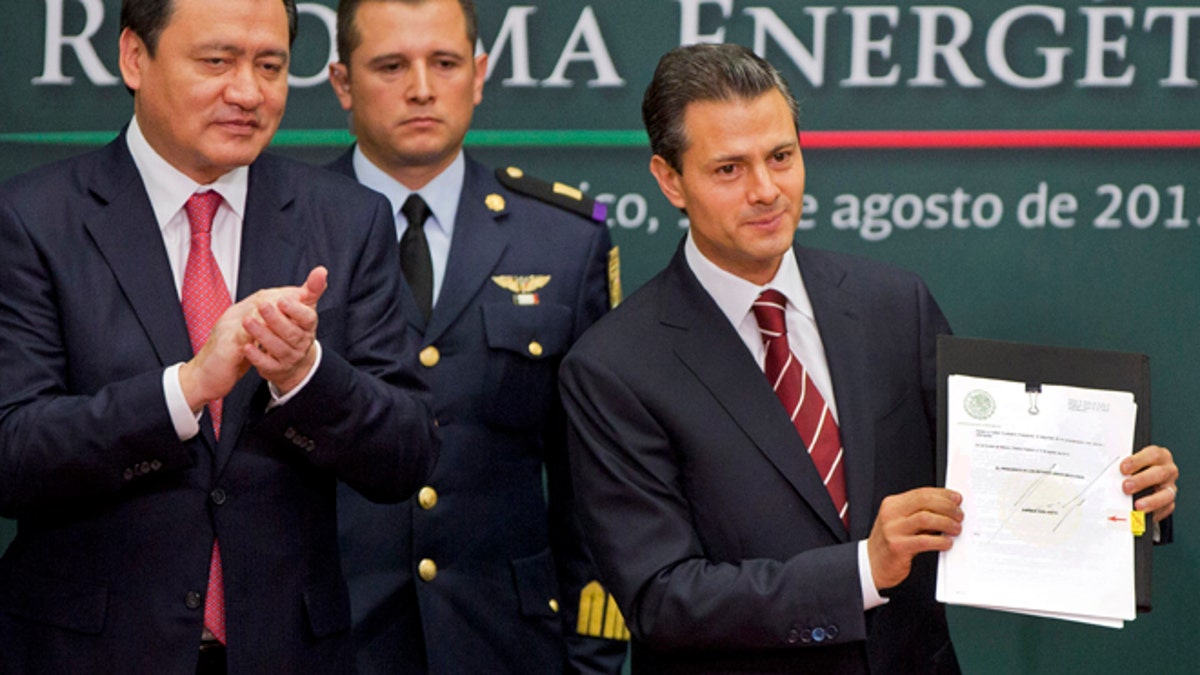
Mexico's President Enrique Pena Nieto, right, shows his proposal that would allow private firms to participate in the oil industry, on Aug.12, 2013. (AP2013)
The Mexican economy has downshifted. Growth forecasts are less than enthusiastic as analyses by the Federal Reserve Bank of Dallas indicate slower production output and a dip in exports, especially to the U.S.
So credit Mexican President Enrique Peña Nieto for not accepting the status quo. His administration from day 1 has embraced an aggressive reform agenda in areas like labor, education and taxation.
These reforms aren’t without controversy. Images of huge protests in Mexico City over his plan to dramatically curtail the influence of the country’s teacher unions provide a glimpse at what a shock to system he’s given an entrenched bureaucracy. Just wait until the energy sector gets an overhaul.
By liberalizing its energy sector, [Mexico] can attract new investment, deliver cheaper and more reliable electricity to its citizens and firms manufacturing for export, and grow new jobs in an economy that has hit a rough patch.
Travel around Mexico and you’ll see the ubiquitous PEMEX gas stations. Unlike in the U.S. where drivers can choose from various brands and product offerings from one corner to the next, the Mexican gas consumer has only one option: the state-owned Petroleos Mexicanos.
That lack of competition for the state-run monopoly has turned a point of national pride into an aging dinosaur unable to compete in the global market or collaborate with foreign investors. In fact, foreign companies are forbidden by Mexico’s constitution from tapping into the Mexican market. All of this leads to high prices, poor service and an outdated way of doing business.
- Joint U.S.-Mexico Gulf Oil Drilling Deal Held Up Over Disagreements In Congress
- Buying Mexico: Americans Salivate Over Owning A Slice Of Pacific Beachfront; Locals Mixed
- Music Group’s ‘Virtual Kidnapping’ Highlights Latest Extension Of Mexico’s Drug War
- Four Days After Monster Truck Tragedy In Mexico, No Officials Yet Held Accountable
But it’s that prospect of opening the Mexican energy sector to foreign investment that could prove to be Peña Nieto’s greatest lobbying challenge. According to polling data released last month, a majority of Mexicans support the idea of reforming Pemex, but over 60 percent oppose outside foreign investors gaining a foothold in the country’s energy sector.
This is different than clashes over education reform. Mexico’s public education system is largely an embarrassment, not engrained in the national identity like Pemex. While most Mexicans recognize that Pemex’s best days are behind it, the skepticism over meddling by outside interests is powerful. Peña Nieto will have to convince the Mexican people that his reform package will grow the Mexican economy and create jobs, not sell off Mexico’s natural resources to the highest bidder.
The prospects for cross-border cooperation in the energy sector are really exciting. Energy exploration in the U.S. is booming right now. The International Energy Agency says the U.S. will be a net exporter of natural gas by 2020 and self-sufficient in energy by 2035. The advent of fracking technology has been an absolute game changer.
Our friends south of the border are poised to make their own dramatic moves in energy exploration, but they need the technical expertise of international oil and gas firms to make it happen. But such strategic partnerships need to be mutually beneficial. Oil firms aren’t going to make investments in Mexico unless they’re certain it will be worth their while and will get paid.
In the U.S. Congress, the House has passed and sent to the Senate the Outer Continental Shelf Transboundary Hydrocarbon Agreements Authorization Act. If the bill becomes law, it would implement the Transboundary Hydrocarbons Agreement signed by the U.S. and Mexico last year, which establishes the framework for developing the oil and gas reserves that cross the maritime boundary between the two countries. It’s a critical component for the further modernization of Mexico’s energy sector and it gives U.S. energy firms a chance to further explore the Gulf of Mexico. The EX-IM bank had already put their money where their mouth is by authorizing over $1.5 billion in support of U.S. goods and services to Pemex.
Mexico is on the cusp of giving its economy a major shot of adrenaline. By liberalizing its energy sector, the country can attract new investment, deliver cheaper and more reliable electricity to its citizens and firms manufacturing for export, and grow new jobs in an economy that has hit a rough patch. It’s the next step in shifting the Mexican economy back into high-gear and North America will we be the primary beneficiary. Let’s hope President Peña Nieto has the political touch to get it done.
